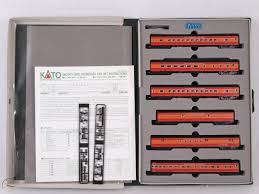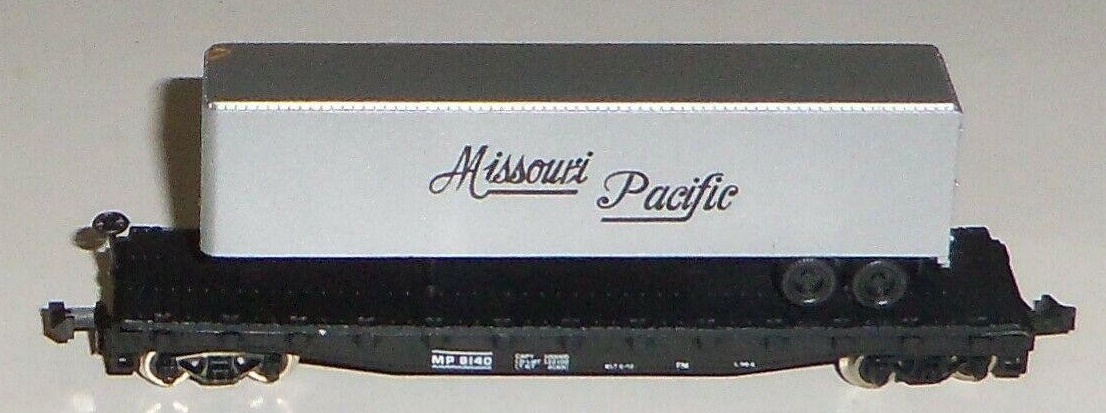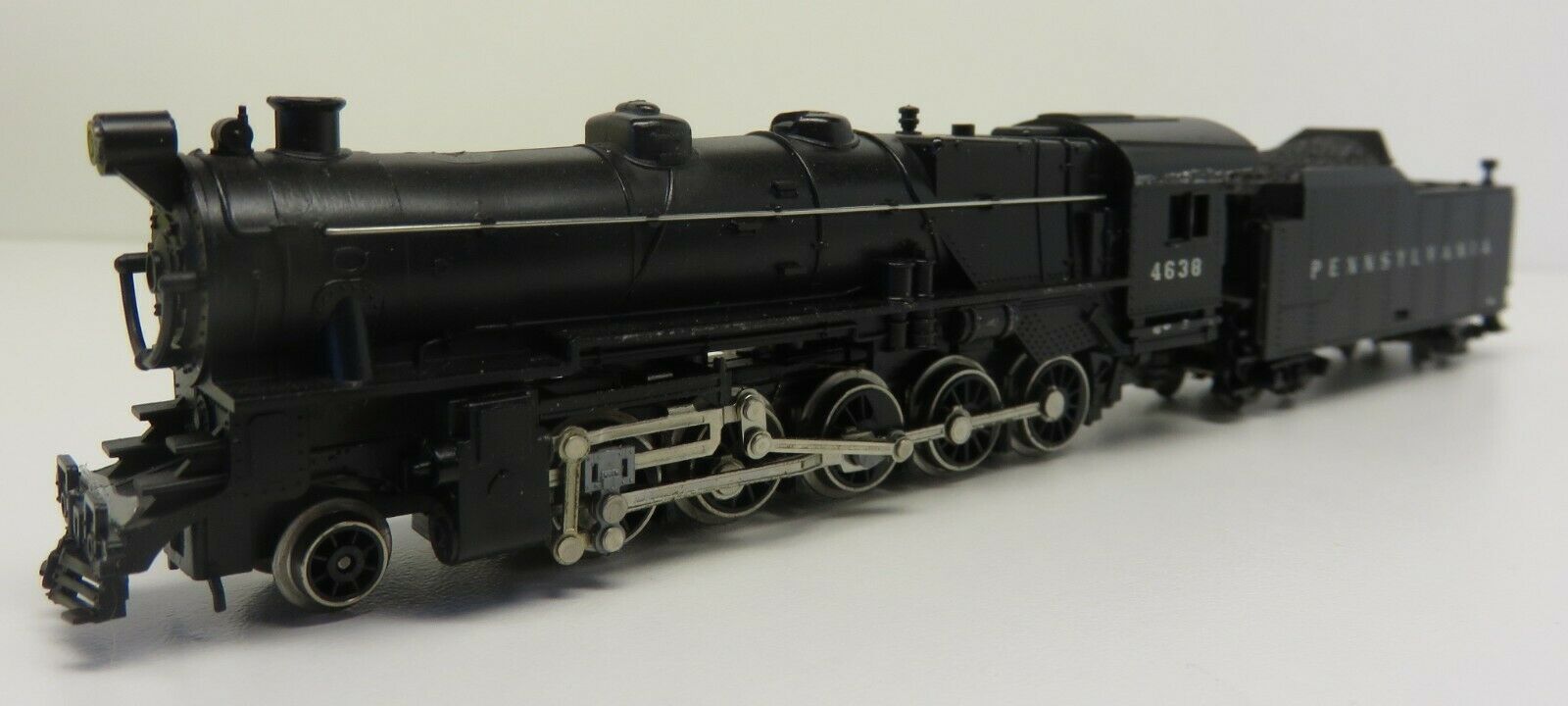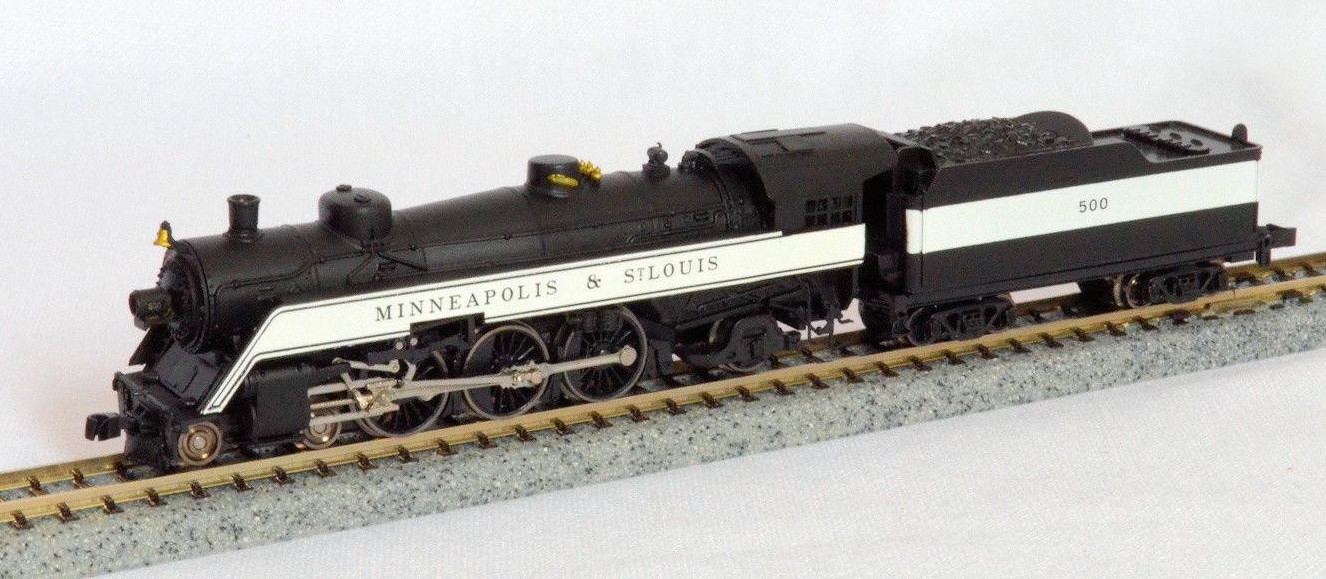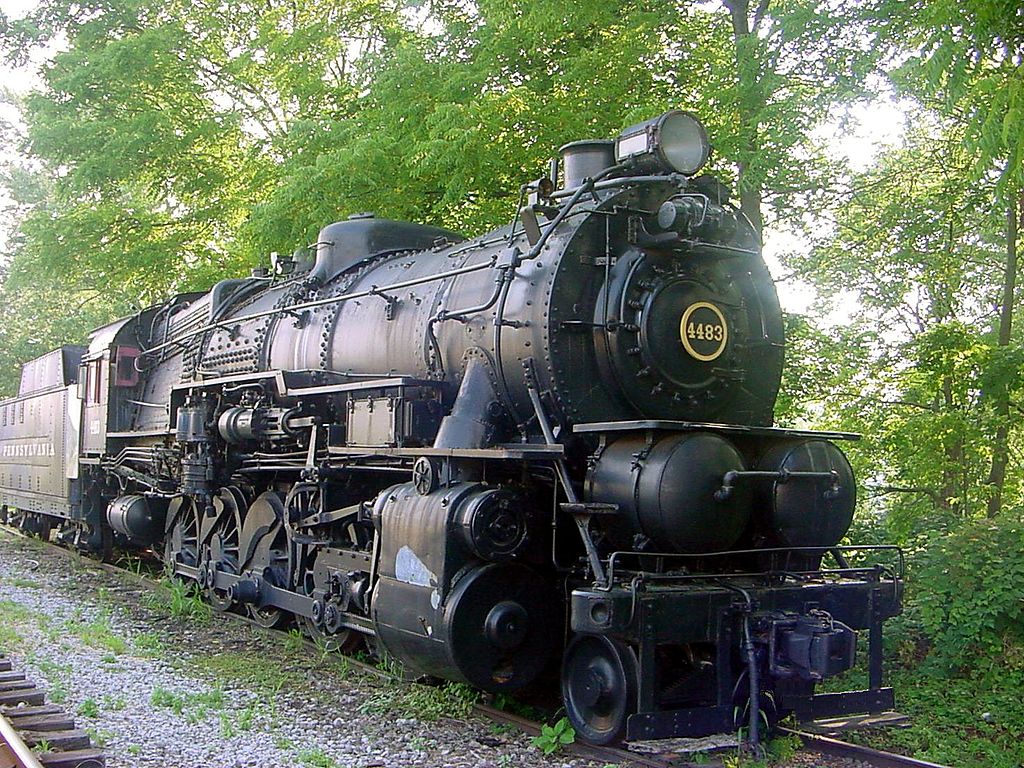Minitrix - 2073 - Locomotive, Steam, 2-10-0 Decapod - Santa Fe - 3260
| Stock Number | 2073 |
| Brand | Minitrix |
| Manufacturer | Minitrix |
| Body Style | Minitrix Steam Engine 2-10-0 Decapod |
| Prototype Vehicle | Locomotive, Steam, 2-10-0 Decapod (Details) |
| Road or Company Name | Santa Fe (Details) |
| Reporting Marks | AT&SF |
| Road or Reporting Number | 3260 |
| Paint Color(s) | Black |
| Print Color(s) | White |
| Coupler Type | Rapido Hook |
| Wheel Type | Nickel-Silver Plated Metal |
| Wheel Profile | Deep Flange |
| DCC Readiness | No |
| Item Category | Locomotives |
| Model Type | Steam |
| Model Subtype | 2-10-0 |
| Model Variety | USRA Decapod |
| Prototype Region | North America |
| Prototype Era | NA Era I: Early Steam (1835 - 1900) |
| Scale | 1/160 |
DCC Information:
This engine is not DCC-Compatible.
Prototype History:
Under the Whyte notation for the classification of steam locomotives, 2-10-0 represents the wheel arrangement of two leading wheels on one axle, ten powered and coupled driving wheels on five axles, and no trailing wheels. This arrangement was often named Decapod, especially in the United States, although this name was sometimes applied to locomotives of 0-10-0 "Ten-Coupled" arrangement, particularly in the United Kingdom. In the United States, the 2-10-0 was not widely popular but was a favorite of a small number of railroads which operated mostly in mountainous terrain. Among these was the Erie Railroad, a major Chicago to New York trunk line railroad.
The 2-10-0's main advantage was that five out of six of its axles were powered, meaning almost all the weight was available for traction rather than being distributed over pilot and trailing wheels. The long rigid wheelbase caused problems on tightly curved track, so blind drivers were the norm, either on the central axle, and/or on the second and/or fourth axles. Often lateral motion devices were attached to the leading drive axle.
The wheel arrangement's disadvantages included the firebox size restriction caused by the lack of trailing wheel. This meant the firebox was fitted in between the wheels (common on earlier locomotives) and was long and narrow, or if mounted above the driving wheels, was wide and long but shallow. Many locomotives chose the latter option. A firebox mounted over the drivers also restricted the diameter of the driving wheels, which in turn limited speed. As with the Consolidation (2-8-0), "chopping" at speed ensured a rough ride for the crew due to instability caused by the wheel arrangement. In fact, backing any locomotive without a trailing axle was restricted to under twenty miles per hour or less. Most 2-10-0s were not operated at speeds greater than 50 mph (80 km/h).
From Wikipedia
The 2-10-0's main advantage was that five out of six of its axles were powered, meaning almost all the weight was available for traction rather than being distributed over pilot and trailing wheels. The long rigid wheelbase caused problems on tightly curved track, so blind drivers were the norm, either on the central axle, and/or on the second and/or fourth axles. Often lateral motion devices were attached to the leading drive axle.
The wheel arrangement's disadvantages included the firebox size restriction caused by the lack of trailing wheel. This meant the firebox was fitted in between the wheels (common on earlier locomotives) and was long and narrow, or if mounted above the driving wheels, was wide and long but shallow. Many locomotives chose the latter option. A firebox mounted over the drivers also restricted the diameter of the driving wheels, which in turn limited speed. As with the Consolidation (2-8-0), "chopping" at speed ensured a rough ride for the crew due to instability caused by the wheel arrangement. In fact, backing any locomotive without a trailing axle was restricted to under twenty miles per hour or less. Most 2-10-0s were not operated at speeds greater than 50 mph (80 km/h).
From Wikipedia
Road Name History:
The Atchison, Topeka and Santa Fe Railway (reporting mark ATSF), often abbreviated as Santa Fe or AT&SF, was one of the larger railroads in the United States. Chartered in February 1859, the railroad reached the Kansas-Colorado border in 1873 and Pueblo, Colorado, in 1876. To create a demand for its services, the railroad set up real estate offices and sold farm land from the land grants that it was awarded by Congress. Despite the name, its main line never served Santa Fe, New Mexico, as the terrain was too difficult; the town ultimately was reached by a branch line from Lamy.
The Santa Fe was a pioneer in intermodal freight transport, an enterprise that (at one time or another) included a tugboat fleet and an airline (the short-lived Santa Fe Skyway). Its bus line extended passenger transportation to areas not accessible by rail, and ferryboats on the San Francisco Bay allowed travelers to complete their westward journeys to the Pacific Ocean. The ATSF was the subject of a popular song, Harry Warren & Johnny Mercer's "On the Atchison, Topeka and the Santa Fe", written for the film, The Harvey Girls (1946).
The railroad officially ceased operations on December 31, 1996, when it merged with the Burlington Northern Railroad to form the Burlington Northern & Santa Fe Railway.
Read more on Wikipedia.
The Santa Fe was a pioneer in intermodal freight transport, an enterprise that (at one time or another) included a tugboat fleet and an airline (the short-lived Santa Fe Skyway). Its bus line extended passenger transportation to areas not accessible by rail, and ferryboats on the San Francisco Bay allowed travelers to complete their westward journeys to the Pacific Ocean. The ATSF was the subject of a popular song, Harry Warren & Johnny Mercer's "On the Atchison, Topeka and the Santa Fe", written for the film, The Harvey Girls (1946).
The railroad officially ceased operations on December 31, 1996, when it merged with the Burlington Northern Railroad to form the Burlington Northern & Santa Fe Railway.
Read more on Wikipedia.
Brand/Importer Information:
Trix is a German company that originally made Trix metal construction sets. one of its co-founders was Stephan Bing, the son of the pioneer toy-maker industrialist Ignaz Bing. In 1935 the company began producing the electrically powered model trains that it became famous for, under the Trix Express label. Prior to the outbreak of World War II the Trix company produced a small range of fairly unrealistic AC powered three rail models running at 14 volts.
N gauge models under the Minitrix brand were made from the late 1960s mostly of European prototypes (German and British primarily). North American prototypes were also manufactured and marketed under the Aurora "Postage Stamp" brand; later these items were sold under the American Tortoise, Model Power and Con-Cor brands. Trix sometimes utilized North American consultants to aid in the design of this portion of the product line. The "Hornby Minitrix' brand was used in the 1980s for a short lived range of British outline models using the earlier product tooling.
Trix's owner in the 1980s and 1990s was Mangold, which went bankrupt in the late 1990s and Märklin purchased the assets in January 1997. In part, this purchase was a reflection of Märklin's need for added production capacity; Trix had been manufacturing certain items for Märklin in previous years. The purchase was also in response to the earlier purchase of the Karl Arnold company by the Italian company Rivarossi; Märklin were very keen to take over Trix market share in 2-rail H0 and especially Minitrix, until then Märklin had not marketed N gauge models. In 2003, Märklin introduced its first N gauge models under the well established Minitrix brand. A number Märklin H0 scale three-rail AC locomotives have also been introduced in two-rail DC versions under the Trix logo and many models are shared between the two brands.
From Wikipedia
N gauge models under the Minitrix brand were made from the late 1960s mostly of European prototypes (German and British primarily). North American prototypes were also manufactured and marketed under the Aurora "Postage Stamp" brand; later these items were sold under the American Tortoise, Model Power and Con-Cor brands. Trix sometimes utilized North American consultants to aid in the design of this portion of the product line. The "Hornby Minitrix' brand was used in the 1980s for a short lived range of British outline models using the earlier product tooling.
Trix's owner in the 1980s and 1990s was Mangold, which went bankrupt in the late 1990s and Märklin purchased the assets in January 1997. In part, this purchase was a reflection of Märklin's need for added production capacity; Trix had been manufacturing certain items for Märklin in previous years. The purchase was also in response to the earlier purchase of the Karl Arnold company by the Italian company Rivarossi; Märklin were very keen to take over Trix market share in 2-rail H0 and especially Minitrix, until then Märklin had not marketed N gauge models. In 2003, Märklin introduced its first N gauge models under the well established Minitrix brand. A number Märklin H0 scale three-rail AC locomotives have also been introduced in two-rail DC versions under the Trix logo and many models are shared between the two brands.
From Wikipedia
Item created by: gdm
on 2016-10-24 17:01:02
Last edited by: CNW400 on 2020-08-20 11:40:01
If you see errors or missing data in this entry, please feel free to log in and edit it. Anyone with a Gmail account can log in instantly.
Last edited by: CNW400 on 2020-08-20 11:40:01
If you see errors or missing data in this entry, please feel free to log in and edit it. Anyone with a Gmail account can log in instantly.






